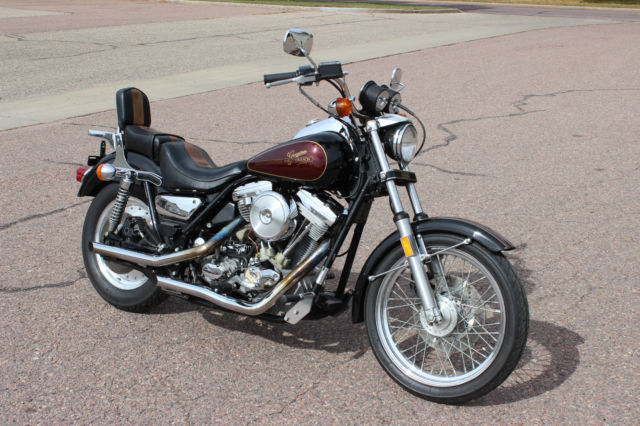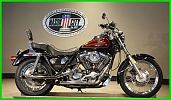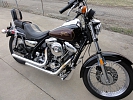1984 Harley Davidson FXRDG Disc Glide FXR FXRS HD Rare Less 860 made Original
1984 Harley-Davidson FXR
| Price: | US $6,000.00 |
| Item location: | Sioux Falls, South Dakota, United States |
| Make: | Harley-Davidson |
| Model: | FXR |
| SubModel: | FXRDG FXRS |
| Type: | Cruiser |
| Year: | 1984 |
| Mileage: | 11,002 |
| VIN: | 1HD1EEL20EY256131 |
| Color: | Black |
| Engine size: | 1,340 |
| Vehicle Title: | Clear |
| Contact seller: | Contact form |
1984 FRXDG Disc Glide
11002 Original miles
Less then 860 Made
This FXRDG isexceptionally original, xcept for tires and exhaust.It runs, hifts, nd rides perfectly. Starts right up.Everything works, linkers, peedometer, ach, tc.From what I've been told this is the first model to be assembled with the evolution engine.It was also the first time Harley offered aChrome Engine package.Chrome Rockers, am Cover, rimary Etc.
Shipping will be paid by the buyer.I can store the bike for a couple of weeks in heated building if payment is PAID IN FULL.
Harley-Davidson's Disc Glide is probably history already. Milwaukee made very few of these high-glitter FXRDG 80-inchers, omething under 860 units, nd by the time you read this it's likely the only Disc Glides available will be used ones. Discgroupies in California fared even worse than in other parts of the United States. The Disc Glide wasn't available at all in the Golden State, victim of California's emission regulations which mandate evaporative control systems on motorcycles built after January 1, 984. The small run of Disc Glides came off the assembly line early in 1984; it wasn't worth the bother to build a special California model.
As a small company, arley-David-son has the flexibility to run off small batches of machines. These motorcycles aren't always "limited editions"; rather Harley's ability to assemble
special detail models in small numbers is just a consequence of being Harley-Davidson. When the price tag reaches the altitude of $8199, ne best be selling something pretty special, n terms of details, roma or whatever, nd in terms of exclusivity—owners are paying dearly not to meet themselves on the road.
The most obvious trait of the Disc Glide is its rear wheel disc; up front a wire-spoke wheel supports things. The more common FXRS and FXRT models have cast wheels. Visual concerns dictated the Disc Glide's rather eclectic wheel-fashion—the motorcycle is supposed to look light and airy toward the front, nd dense and weighted down at the rear. The disc wheel is a composite: two halves, oined by rivets, orm the basic wheel. The aluminum halves aren't "spun" as generally assumed; they are formed in a deep-draw process out of 0.160-inch aluminum. The disc wheel lacks any functional advantage over the standard cast wheel; in fact, ou must run a tube in the rear tire with the disc wheel, nd, t 15 pounds, he disc weighs two pounds more than the latest standard FXRS cast piece. Functional superiority just isn't where the FXRDG is at, r for that matter where any $8000 street motorcycle is at. Applying strict cost/function/benefit tests to motorcycles would have us all riding around on $2500 550cc bikes.
Function had little to do with the 12 chrome-plated aluminum engine covers. Again, testimony to the importance of finish. If dissipation were the overriding concern, hen motorcycle engines would be lumps of rough, lackened castings.
Motorcycle companies avoid chrome on aluminum because it involves an expensive and difficult process. As anyone who's had anything chromed knows, he items to be chromed must have perfect finishes since every flaw shows up through the plate. That much polishing means a lot of labor. Furthermore, n a production setting, onitoring the chemicals and keeping them free from contamination is more bother than it's worth.
While it's doubtful Harley will apply its chrome-plating tech more widely, the company's new paint-implanted graphics probably will find broader application soon. What you see on the side of the FXRDG tank is not a decal. Instead, arley-Davidson uses a process in which the graphic design is implanted into the paint and covered by the clear coats. There are no decal-ridges. Milwaukee lips are zipped on the exact technology: Juneau Avenue state secret.
The Disc Glide has the understated restraint of a banker's furnishings; black, urgundy and gold—with black and brown leather saddle is tame stuff compared to the 1980 Wide Glide with flames on its tank.
If seat height is any guide, XRS owners are getting shorter every year. The seat height, ccording to Harley-Davidson, s down at 26.8 inches, ower by more than an inch from early FXRS twins. In the front, uspension travel remains unchanged; the tubes are shorter and the bike's triple crowns ride lower than before. In the
back, las, he new lower-rider strategy results in shorter rear shocks and the loss of three-quarters of an inch of travel. This hurts the bike's Ground Clearance and sacrifices the comfort and suspension control longer travel can provide. A functional explanation of sorts justifies the dropped seat— less athletic riders feel more secure when they can get their feet flat on the ground as they come to a stop.
Progress does appear in the clutch department: new aluminum alloy clutch basket, ub and pressure plate assembly, ogether with a diaphragm spring. This new wet clutch runs in its own oil bath; the primary drive has its own separate, sealed cavity. The diaphragm spring looks like a thin spring-steel disc-brake rotor, hich, iewed on edge, s slightly convex. Set in place, he diaphragm spring can apply substantial force against the pressure plate—exactly what you want with an 80-cubic-inch engine—but at the clutch lever, hings lighten up. As a diaphragm spring compresses, ts convex shape flattens, nd when this occurs it compresses with less pressure. Hence, here's decreasing resistance from the spring as the rider draws the clutch lever in.
Other than the clutch, hich works marvelously well, nd the reduced suspension travel and Ground Clearance, hich—however necessary for customer acceptance—mark a backWard step from a functional viewpoint, he Disc Glide remains fundamentally the same as the FXRT tested in October 1983, tilizing the same frame, wing arm and engine. Milwaukee has worked hard to get a contemporary motorcycle, nd there's no reason to believe the work will get much easier. The latest burst of Japanese engi-
neering activity has only served to raise the general threshold of contemporary technology higher, nd Milwaukee cannot afford to have the FXR series slip out of date. Harley-Davidson has to give the faithful what they need, hat they want and evidence in terms of fit and finish that their thousands were well spent. A tall order, ndeed, or any low rider, t any price. ?
Also published at eBay.com

















